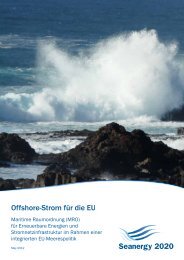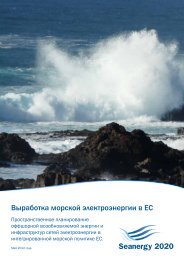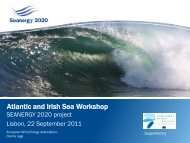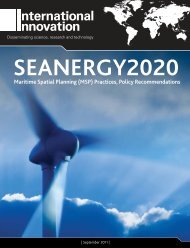Comparative analysis of Maritime Spatial Planning ... - Seanergy 2020
Comparative analysis of Maritime Spatial Planning ... - Seanergy 2020
Comparative analysis of Maritime Spatial Planning ... - Seanergy 2020
You also want an ePaper? Increase the reach of your titles
YUMPU automatically turns print PDFs into web optimized ePapers that Google loves.
4.2 PERMITTING AND LICENSING4.2.1 Barriers and obstaclesIn „cascade‟ licensing processes, such as in Belgium, permits are not valid until the last requiredpermit has been obtained. The last necessary and utterly essential license is the grid connectionagreement. If grid capacity is not ready for the injection <strong>of</strong> ORE production, the permits and theproject cannot be executed. This is the case for 3 consented projects in Belgium that received thefirst required license in 2009 and launched the rest <strong>of</strong> the permitting process. However, as long asthe grid operator has not reinforced its transmission capacities 53 , the domain concession,construction and environmental and subsea cable permits will remain suspended.The permitting process in the Netherlands seems to be very disparate with 11 laws and regulationsto consider, <strong>of</strong> which five are related to environmental protection, which may seem to some extendexaggerated. After all, ORE production is the most environmental friendly way <strong>of</strong> producing energy, sothe environmental permits could be harmonised or merged for the purpose <strong>of</strong> ORE projects. The gridconnection and the permit for the subsea cable are excluded from this licensing process and must behandled at local level.4.2.2 Good practicesDenmark has based the licensing process on the Act for the Promotion <strong>of</strong> Renewables (2009). Otherauthorities are involved in the licensing process with a statutory role. It is certainly interesting to seethat a licensing process for ORE is piloted by a national energy administration.In Germany, the legal basis for the licensing process in the EEZ is the <strong>Maritime</strong> <strong>Spatial</strong> Plan for theNorth Sea and the Baltic Sea. In the 12 nautical mile zone (TS), the <strong>Spatial</strong> Plans <strong>of</strong> the Länder apply.As regards the grid license, a federal law obliges the transmission grid operators (TSO) to ensure gridconnection <strong>of</strong> a consented <strong>of</strong>fshore wind farm. The obligation to connect ORE production to the gridhas a firm legal basis in Germany, situation which <strong>of</strong>fers tight legal certainty and results in lessinvestment costs 54 for ORE developers. The UK requests six types <strong>of</strong> licenses for ORE projects, but aunique advantage <strong>of</strong> the permitting system <strong>of</strong> the UK is that once they are obtained, the permits arevalid indefinitely.4.2.3 Policy recommendations• Ensure a good permit and licensing process based – ideally – on a combination <strong>of</strong> all goodNorth Sea MSP practices related to ORE development that:53 Expected in 2014-2015, but dependent on successful outcome <strong>of</strong> onshore permitting process <strong>of</strong>transmission lines.54 Since the ORE developer does not have to invest in the subseacable which constitutes +/- 15 % <strong>of</strong> CAPEX<strong>of</strong> an <strong>of</strong>fshore wind farm.Deliverable D 2.381 | P a g e






